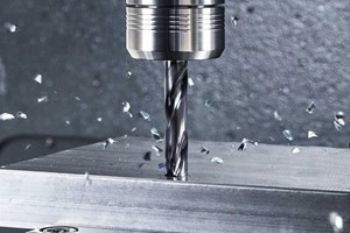
The range of WTX solid-carbide drills from Sheffield-based WNT (UK) Ltd (
www.wnt.com) has been extended to include drills that are capable of drilling up
to 50x diameter in steel and 30x diameter in aluminium.
Moreover, with the correct set-up, it is possible to drill to these depths without the need for a pecking cycle.
The WTX UNI for steel and WTX ALU for aluminium share common features such as a 135deg point angle and a straight cutting edge that helps to reduce the cutting forces.
Another feature is the use of four guide lands (six on ALU drills) that help the drills to maintain alignment — and achieve an accuracy to h7 specification. The drills also feature polished flutes and through-coolant.
Differentiating the drills are their coatings: UNI drills have a TiAlN multi-layer coating, while ALU drills have a DLC (Diamond Like Carbon) coating.
WNT says that these drills provide an alternative to gun drilling, highlighting the example of drilling operations on a 42CrMoS4 chrome molybdenum steel crankshaft.
The customer had been drilling 12 holes per crankshaft using a 5mm-diameter gun drill with a cutting speed of 78m/min and a feed rate of 0.03mm/rev.
Switching to a WNT UNI drill saw the cutting speed increased to 81m/min and the feed raised to 0.1mm/rev, for a saving in cycle time of 26sec per hole. Furthermore, the drill life increased from 50 crankshafts per drill to 97.
The WTX deep-hole drill range covers diameters from 2 to 12mm with diameter to length ratios of 16x, 20x and 24x. For 40x, the diameter range is 3-9mm, while 50x is restricted to diameters in the range 3-6.8mm.
The only requirement for the efficient use of these drills is a pilot hole to a depth of 3x the drill diameter, a reduction in speed and feed when entering the pilot hole, and a reduction in speed when the drill is retracted from the finished hole.